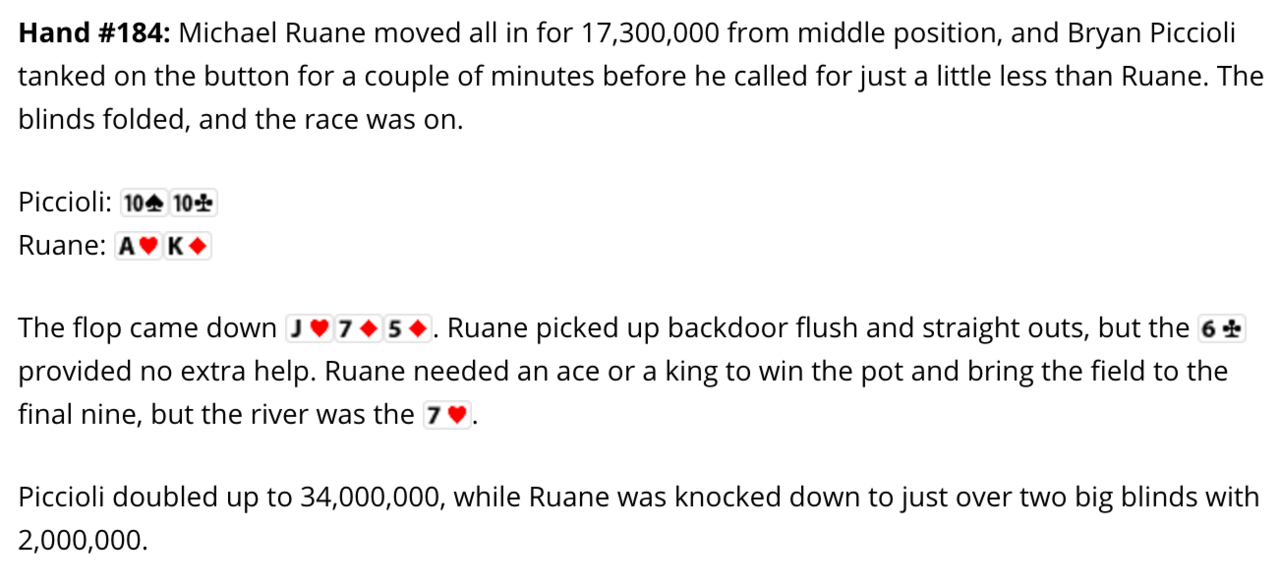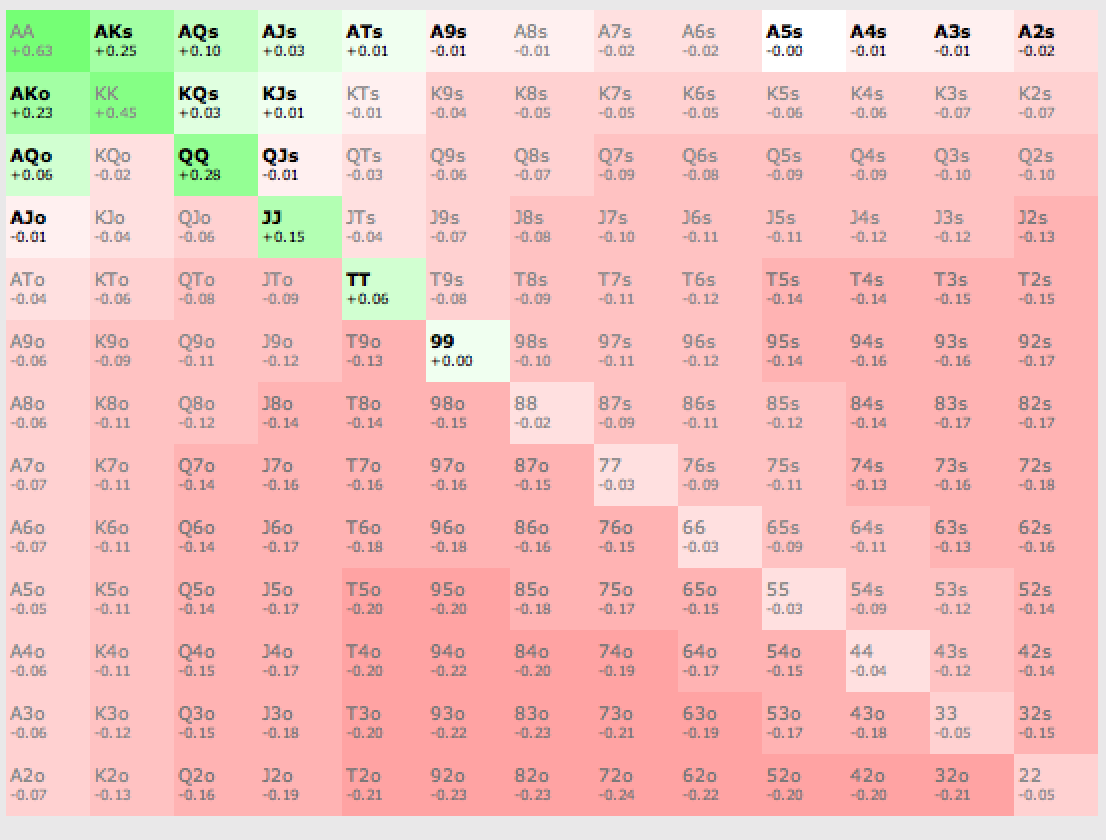This morning I wrote a blog that listed how much each player's equity was, and a brief overview of ICM.
With 10 left in the event, there was an interesting hand that deserves some discussion. Analyzing it properly involves using ICM to make decisions, and should be fairly instructive on how to navigate close spots deep in tournaments.
The Hand

With blinds at 400k/800k and a 100k ante, Michael Ruane moved all in for 22bb from the LJ (3 before the button). Bryan Piccioli called off all his chips for 19.5bb. They were the two shortest stacks remaining, but 5 others had less than double either of them.
What hands can Michael profitably open shove?
I like to use a program called Holdem Resources Calculator, which can quickly calculate nash equilibriums based on the stacks and payouts. Initially I'll just play around with settings for open shoving to see what hands are profitable, but there are other options, which take much longer to run, but allow for limping, open raising, 3betting, etc.
The nash equilibrium shoving range for Michael, if he shoves or folds every hand in his range, is this:
11.2%, 99+ A2s+ AJo+ KTs+ KQo QJs
This probably seems really wide, but basically everyone behind can only call with JJ+ or AK (the SB can call with TT, and the BB can additionally call with 99 since he has a big stack), so by shoving suited broadway cards or suited Ax, you block many calling hands others have. This is why A2s can be a shove while 88 is a fold: 88 blocks nothing opponents call with, but A2s both blocks AK/AA and is in better shape against TT+ when called.
However, there is no way Michael is open shoving AA here, and probably not KK either. These hands are strong enough that he wants action. But by not shoving AA/KK here, he must remove some of the weaker hands from his shoving range because now his shoving range is much weaker, so more hands can call him, which makes the shoves that were closer to 0 EV folds.
By removing the AA and KK shoves but keeping any shoves that remain in a nash equilibrium, Michael's new shoving range is all the hands that are green on this chart (minus AA/KK):

So now, Michael can profitably shove QQ-99, AQo+, ATs+ A3s-A5s, KJs+, if he were an average player at this final table, and if other players are calling tight. The problem is he's a better than average final table player, and the big blind is likely to call looser because he has a lot of chips and is a recreational player, and other players at the table my call with TT (as evidenced by Bryan calling with it).
If I adjust the BB's calling range to include just 88, and Bryan to call TT, and Michael avoids all very close to breakeven shoves (let's say less than .03bb), then his open shoving range will be:

AQo+, AJs+, KQs, TT+
However, by shoving that tight of a range, now his opponents can only call with QQ+ AKs, AKo, which makes a very wide range of hands a shove for him!
If Michael could analyze this hand in detail before deciding on a strategy, this is the process he would go about:
Iteration 1
Michael looks at the hands he can profitably shove with the payouts and stacks, assuming everyone else plays perfectly.
In this instance, his initial range was:
99+ A2s+ AJo+ KTs+ KQo QJs
Iteration 2
Michael then removes the hands he would prefer to raise small such as AA/KK, then looks at the hands he can profitably shove with the payouts and stacks, assuming everyone else plays perfectly.
New range:
QQ-99, AQo+, ATs+ A3s-A5s, KJs+
Iteration 3
Michael removes close to breakeven hands that he can play in another manner, and adjusts the calling ranges of others at the final table to what he thinks.
In this case, he would only be shoving AQo+, AJs+, KQs, TT+
Iteration 4
Readjust this range given that he would prefer to shove some other hands like 99 and is fine open raising hands like suited broadways because they flop a bit better.
The problem is he has no time to do this and no software to help him at the table. He just needs to decide what range he will shove from each position in seconds based on his experience.
I suspect Michael was probably shoving something along the lines of AQs, AK, 99-QQ, and open raising to 2-2.25bb with AA, KK, 88, 77, ATs-AJs, AQo, KTs+, KQo, QTs+, JTs, T9s. This means the button can probably only call with QQ+ AKs AKo.
Conclusion
No matter what range I put in for Michael's shoving range, TT was a fold on the button. Having 19bb in the main event, even if you're the short stack, is too valuable at a ten handed table to call off vs a player in the LJ (3 away from button). I'm sure after 7 long days of playing, Bryan simply miscalculated how loose Michael would be in this spot. He probably assumed (correctly) that Michael wouldn't shove AA/KK, but maybe thought his range was 88-QQ AK AQs, and that he sometimes wouldn't open rip QQ (and just raise smaller instead), and that he may even shove some suited Ax. Against a range like that it is really close and I don't blame him for calling, but the earlier lesson in ICM explains why everyone needs to call tighter in a spot like this. And that is amplified when there are still some recreational players at a table, and there are perhaps additional sponsorship opportunities by making the final 9 instead of finishing 10th.
TLDR
Poker is complex, using nash equilibriums alongside ICM gives general guidelines of what to play in certain situations, but these ranges need to be adjusted further based off Player experience (i.e. minraising certain hands that don't mind seeing a flop like KQs, while shoving vulnerable strong hands like 99) and opponent tendencies.
My name is Ryan Daut and I'd love to have you as a follower. Click here to go to my page, then click  in the upper right corner if you would like to see my blogs and articles regularly.
in the upper right corner if you would like to see my blogs and articles regularly.

I am a professional gambler, and my interests include poker, fantasy sports, football, basketball, MMA, health and fitness, rock climbing, mathematics, astrophysics, cryptocurrency, and computer gaming.
